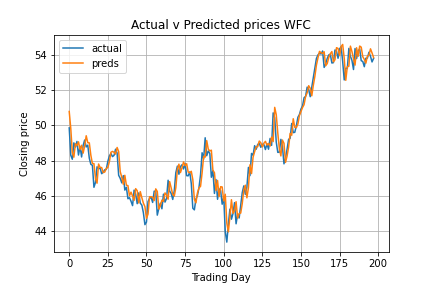A work-in-progress
The project implements a Recurrent Neural Network (RNN) in the form of two Long Short-Term Memory (LSTM) layers to attempt to predict future closing prices for stocks.
Data is pulled via the tiingo API, which includes daily values for open, high, low, close and trading volume of a wide variety of symbols. We chose symbols listed under the New York Stock Exchange.
Predictions are made using raw data, even though we computed other composite metrics like Stochastic Oscillator indices, weighted averages, Bollinger bands. More work is needed to incorporate those metrics in the network which will hopefully result in more accurate predictions. The 3 features in the data are open, high and low values which are used to attempt to predict how the close price will look like at the end of the trading day. The data aren't scaled, though future work will probably involve a scaling transformation.
Our model currently is a sequential single layer LSTM RNN + Dense, though future work will add one more LSTM layer. 100 LSTM nodes are currently used. Rectified Linear Units (ReLU) are used as activation functions and Adam as the optimiser.
model = Sequential()
model.add(LSTM(100, activation="relu", input_shape=(n_steps, n_features)))
model.add(Dense(n_features))
opt = Adam(learning_rate=0.001)
model.compile(optimizer=opt, loss="mae", metrics=["mse"])
Trying to fit the model onto the testing data seems to work, not as accurate as I would like it to be. Reported MAE and MSE for WFC dataset:
History Item [loss] reports value of 0.016902789101004602
History Item [mse] reports value of 0.0005050316685810685
Will further tinker with learning rate, loss function, activation function, node count, etc.
LSTM pulls ahead of ARIMA with lower Mean Squared Errors and Mean Absolute Errors:
LSTM mean: 0.000331696789897865
ARIMA mean: 0.0005229507475626473
This is exactly what we wanted to show in the paper, so far so good.
The usual python data stack is used in this project:
- pandas
- numpy
- sklearn
- statsmodels
For deep learning we are using:
- Keras
- TensorFlow

